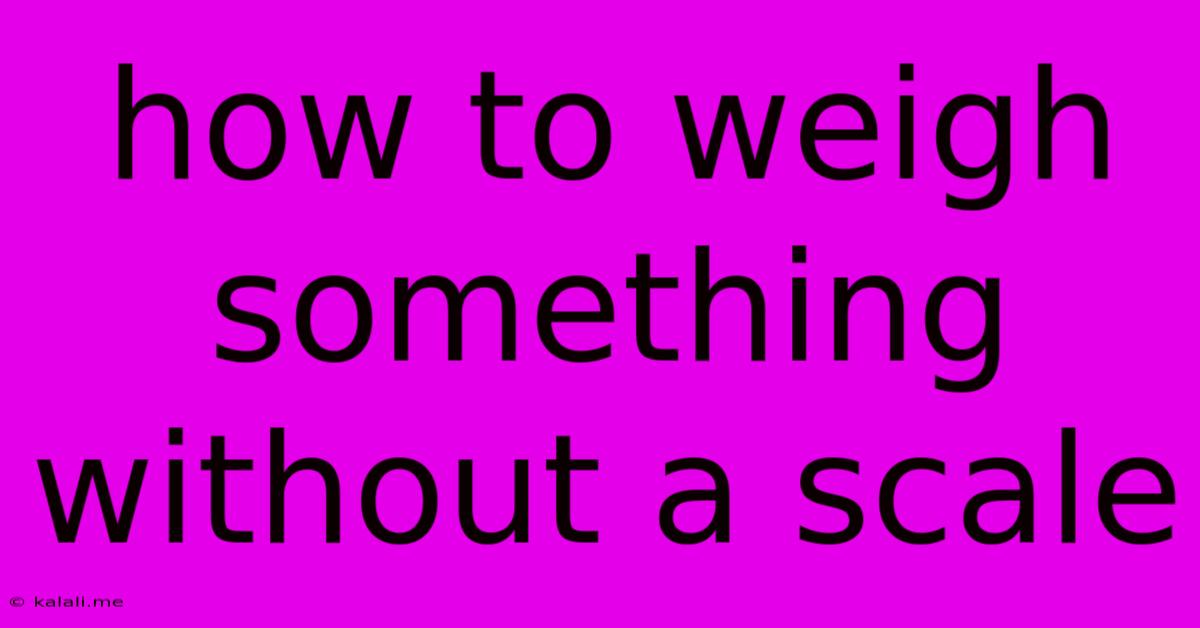How To Weigh Something Without A Scale
Kalali
Jun 02, 2025 · 3 min read

Table of Contents
How to Weigh Something Without a Scale: Ingenious Methods for Everyday Needs
Meta Description: Discover clever and surprisingly accurate ways to weigh objects without using a scale, perfect for situations where a scale isn't available. Learn about using water displacement, comparing to known weights, and leveraging everyday tools for estimations.
Weighing something without a scale might seem impossible, but with a bit of ingenuity and the right techniques, you can achieve surprisingly accurate results. This is particularly useful in situations where a scale is unavailable, broken, or simply impractical. This article explores several methods, ranging from simple estimations to more precise techniques.
Method 1: Water Displacement (Archimedes' Principle)
This method is surprisingly accurate for determining the volume and, by extension, the mass of irregularly shaped objects. It relies on Archimedes' principle, which states that the buoyant force on an object submerged in a fluid is equal to the weight of the fluid displaced by the object.
What you need:
- A container that can be filled with water (e.g., a graduated cylinder, a measuring cup, or even a clear bowl).
- Water.
- The object you want to weigh.
Steps:
- Fill the container with water: Note the initial water level.
- Submerge the object: Carefully place the object into the container, ensuring it's fully submerged. Note the new water level.
- Calculate the volume: Subtract the initial water level from the final water level. This gives you the volume of the object in milliliters (mL), which is equal to cubic centimeters (cm³).
- Estimate the mass: Knowing the volume and assuming the object's density (you can look up the density of common materials online), you can estimate its mass. The formula is: Mass = Density x Volume. For example, the density of water is 1 gram per cubic centimeter (g/cm³). If the object displaces 100mL of water, its volume is 100cm³, and if it has a similar density to water, it would weigh approximately 100 grams. Remember this is an estimation and accuracy depends on knowing the object's density.
Note: This method is best suited for objects that don't absorb water or react with it.
Method 2: Using Known Weights for Comparison
This method relies on having objects of known weight to compare to your unknown object.
What you need:
- Objects of known weight (e.g., coins, weights from a weight set – if you have any).
- A balance point (e.g., a ruler balanced on a pencil, a sturdy stick).
Steps:
- Balance the known weight: Place a known weight on one end of your balance.
- Balance the unknown object: Place the unknown object on the other end, adjusting its position until it balances the known weight.
- Estimate the weight: If the unknown object balances with a known weight, it has approximately the same weight. If you need to adjust the position to achieve balance, it implies a relative difference in weight. This method is less precise than water displacement but provides a reasonable estimation.
Method 3: Leveraging Everyday Tools (Estimation)
This method is the least precise but the easiest and requires no special tools. It's best for very rough estimations.
What you need:
- Your hands and a sense of weight estimation (experience is key!)
Steps:
- Lift the object: Carefully lift the object using your hands.
- Compare to known weights: Mentally compare the weight of the object to objects of known weight that you’ve handled frequently (e.g., a bag of sugar, a liter of water).
- Make a reasonable guess: Based on the comparison, estimate the weight of the object.
This method is heavily reliant on experience and personal judgment. It's only suitable for rough estimations, and you'll get better at it with practice.
Conclusion
Weighing something without a scale requires some resourcefulness, but these methods offer various levels of accuracy depending on your needs and the available resources. Remember to always prioritize safety when handling objects and to carefully consider which method is most appropriate for your situation. While not as precise as using a scale, these techniques are valuable alternatives when precise measurements aren't critical.
Latest Posts
Latest Posts
-
Will Adding A Porch Stop A Basement From Leaking Water
Jun 04, 2025
-
Furnace Blows Cold Air Before Heat
Jun 04, 2025
-
Who Pays A Higher Dividend Voo Or Splg Etf
Jun 04, 2025
-
Old Wine Skin Vs New Wine Skin
Jun 04, 2025
-
Does The Quran Mention The Bible
Jun 04, 2025
Related Post
Thank you for visiting our website which covers about How To Weigh Something Without A Scale . We hope the information provided has been useful to you. Feel free to contact us if you have any questions or need further assistance. See you next time and don't miss to bookmark.